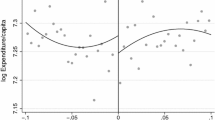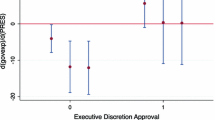Abstract
The consequences of institutional change in the budgetary process are not generally determinate independent of the preferences of political actors. Nonetheless, this study shows for a general class of preference configurations that the legislative branch cannot be made better off by a spending limitation unless the executive is empowered with a line-item veto. In the absence of executive item-veto authority there is no incentive for the legislature to constrain spending.
Similar content being viewed by others
References
American Enterprise Institute (1984). Proposals for line-item veto authority. Washington, DC: American Enterprise Institute for Public Policy Research.
American Enterprise Institute (1985). Budget reform proposals. Washington, DC: American Enterprise Institute for Public Policy Research.
Arrow, K.J. (1963). Social choice and individual values, 2nd ed. New Haven: Yale University Press.
Carter, J.R. and Schap, D. (1987). Executive veto, legislative override, and structure-induced equilibrium. Public Choice 52 (3): 227–244.
Carter, J.R. and Schap, D. (1989). Line-item veto: Where is thy sting? Journal of Economic Perspectives, forthcoming.
Cohen, L. (1979). Cyclic sets in multidimensional voting models. Journal of Economic Theory 20: 1–12.
Crain, W.M. and Tollison, R.D. (1979). Constitutional change in an interest group perspective. Journal of Legal Studies 8 (January): 165–175.
Dearden, J.A. and Husted, T.A. (1988). Executive budget proposal, executive veto, legislative override and uncertainty: A comparative analysis of the budgetary process. Working paper, American University.
Denzau, A.T. and Mackay, R.J. (1981). Structure-induced equilibrium and perfect-foresight expectations. American Journal of Political Science 25 (November): 762–779.
Denzau, A.T. and Mackay, R.J. (1983). Gatekeeping and monopoly power of committees: An analysis of sincere and sophisticated behavior. American Journal of Political Science 27 (November): 740–761.
Enelow, J.M. and Hinich, M.J. (1987, March). Uncertainty and the new institutionalism: The existence of a structure-induced equilibrium. Paper presented at the Public Choice Society Meetings.
Fairlie, J.A. (1917). The veto power of the state governors. American Political Science Review 11 (August): 473–493.
Ferejohn, J. and Krehbiel, K. (1987). The budget process and the size of the budget. American Journal of Political Science 31: 296–320.
Kiewiet, D.R. and McCubbins, M.D. (1986). Presidential influence on congressional appropriations decisions. Social Science Working Paper 601, California Institute for Technology.
Krehbiel, K., Shepsle, K. and Weingast, B.R. (1987). Why are congressional committees powerful? American Political Science Review 81 (September): 829–845.
Line-Item Veto Controversy (1985). Congressional Digest 64 (November): 259–288.
Mackay, R.J. and Weaver, C.L. (1981). Agenda control by budget maximizers in a multi-bureau setting. Public Choice 37 (3): 447–472.
Mackay, R.J. and Weaver, C.L. (1984, November), The power to veto. Paper presented at the Southern Economic Association Meetings.
Romer, T. and Rosenthal, H. (1978). Political resource allocation, controlled agendas, and the status quo. Public Choice 33 (4): 27–45.
Schap, D. (1986). Executive veto and informational strategy: A structure-induced equilibrium analysis. American Journal of Political Science 30 (November): 755–770.
Schap, D. (1988). In search of efficacious executive veto authority. Public Choice 58 (3): 247–257.
Schap, D. (1989). Executive veto and spending limitation: Empirical analysis of the implications for institutional choice. Working paper, College of the Holy Cross.
Schick, A. (1981). The three-ring budget process: The appropriations, tax, and budget committees in Congress. In T.E. Mann and N.J. Ornstein (Eds.), The new Congress, 288–328. Washington, DC: American Enterprise Institute for Public Policy Research.
Schwartz, T. (1981). The universal instability theorem. Public Choice 37 (3): 478–502.
Shepsle, K.A. (1978). The giant jigsaw puzzle: Democratic committee assignments in the modern house. Chicago: University of Chicago Press.
Shepsle, K.A. (1979a). Institutional arrangements and equilibrium in multidimensional voting models. American Journal of Political Science 23 (February): 27–59.
Shepsle, K.A. (1979b). The role of institutional structure in the creation of policy equilibrium. In D.W. Rae and T.J. Eismeier (Eds.), Public choice and public policy, 249–281. Beverly Hills: Sage.
Shepsle, K.A. (1986). Institutional equilibrium and equilibrium institutions. In H.F. Weisberg (Ed.), Political science: The science of politics, 51–81. New York: Agathon Press.
Shepsle, K.A. and Weingast, B.R. (1981). Structure-induced equilibrium and legislative choice. Public Choice 37 (3): 503–519.
Shepsle, K.A. and Weingast, B.R. (1982). Institutionalizing majority rule: A social choice theory with policy implications. American Economic Review 72 (May): 367–371.
Shepsle, K.A. and Weingast, B.R. (1984a). Political solutions to market problems. American Political Science Review 78 (June): 417–434.
Shepsle, K.A. and Weingast, B.R. (1984b). Uncovered sets and sophisticated voting outcomes with implications for agenda institutions. American Journal of Political Science 28 (February): 49–74.
Shepsle, K.A. and Weingast, B.R. (1987). The institutional foundations of committee power. American Political Science Review 81 (March): 85–104.
Smith, S.S. and Deering, C.J. (1984). Committees in Congress. Washington: Congressional Quarterly.
Symposium on the Line-Item Veto (1985). Notre Dame Journal of Law, Ethics and Public Policy 1 (2): 157–283.
Weingast, B.R. (1981). Regulation, reregulation, and deregulation: The political foundations of agency clientele relationships. Law and Contemporary Problems 44 (Winter): 147–177.
Weingast, B.R. and Moran, M.J. (1983). Bureaucratic discretion or congressional control: Regulatory policymaking by the Federal Trade Commission. Journal of Political Economy 91 (October): 765–801.
Wildavsky, A. (1985). Item veto without a global spending limit: Locking the treasury after the dollars have fled. Notre Dame Journal of Law, Ethics and Public Policy 1 (2): 165–176.
Author information
Authors and Affiliations
Additional information
This study was undertaken while the author was Visiting Scholar at the Center for Study of Public Choice. Akira Yokoyama provided helpful comments on an early version of the paper. Financial assistance from both Holy Cross College and the Center for Study of Public Choice is gratefully acknowledged.
Rights and permissions
About this article
Cite this article
Schap, D. Executive veto and spending limitation: Positive political economy with implications for institutional choice. Public Choice 65, 239–256 (1990). https://doi.org/10.1007/BF00204948
Issue Date:
DOI: https://doi.org/10.1007/BF00204948




